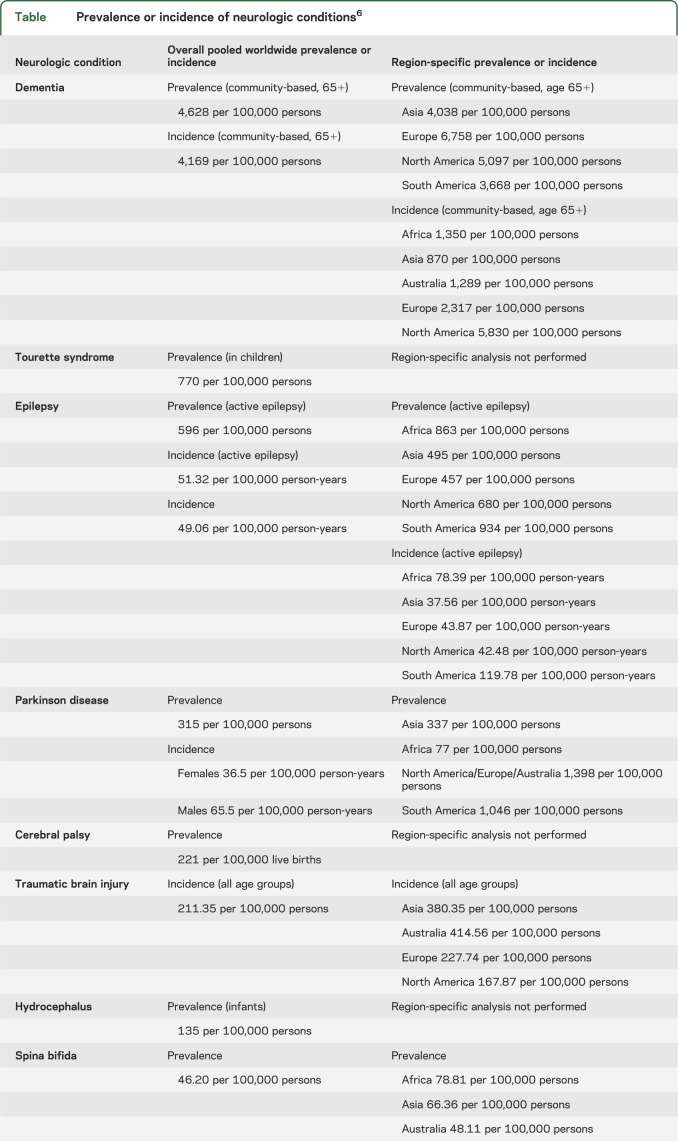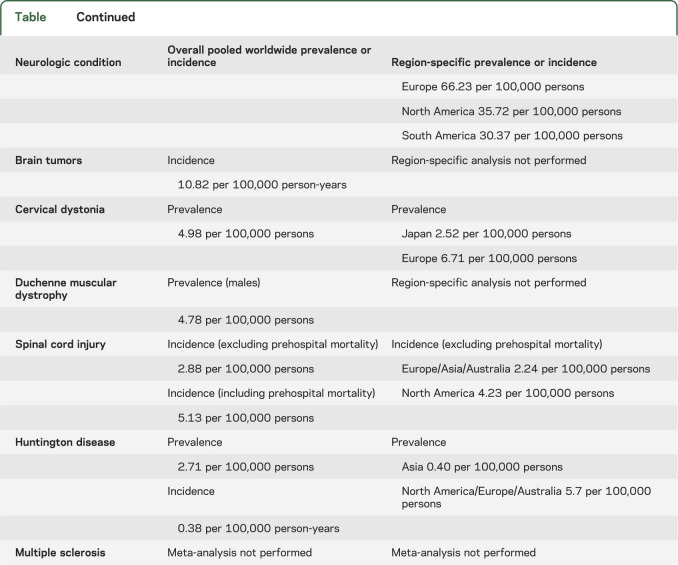In an effort to better understand the global burden of neurologic conditions, the Public Health Agency of Canada launched the National Population Health Study of Neurological Conditions (NPHSNC) in 2009.1 One of the many aims of the NPHSNC was to examine the epidemiology, including the incidence and prevalence, of 15 neurologic conditions: Alzheimer disease (AD) and related dementia, amyotrophic lateral sclerosis (ALS), brain tumors, cerebral palsy, dystonia, epilepsy, Huntington disease (HD), hydrocephalus, multiple sclerosis, muscular dystrophy, Parkinson disease (PD), spina bifida, spinal cord injury (SCI), Tourette syndrome, and traumatic brain injury (TBI). In addition to performing systematic reviews on the worldwide incidence and prevalence of these neurologic conditions, we examined issues arising as a result of heterogeneity in the conduct of international epidemiologic studies in neurology.
This tremendous effort involved the review of 65,529 abstracts and 4,650 full-text articles, with 1,242 research studies ultimately included in our systematic reviews. Incidence studies were less frequently performed than prevalence studies, except for SCI and TBI, where most studies (>90%) were incidence studies. Our critical appraisal and evaluation of hundreds of primary research studies allowed us to make conclusions regarding the most common sources of heterogeneity between epidemiologic studies in neurology. Within conditions, methodology and estimates varied substantially between studies and even within regions. For example, I2 value (a statistical test of heterogeneity ranging between 0% and 100%, with lower values representing lower heterogeneity) ranged from a low of 67% for Duchenne muscular dystrophy studies, followed by 83.6% for ALS, 89.6% for cerebral palsy, and was greater than 90% for most other conditions studied. In fact, heterogeneity between multiple sclerosis studies was so extensive that meta-analyses even by regions were not possible.2
Possible influences of research methodology on estimates of incidence/prevalence.
Diagnostic criteria.
The diagnostic criteria used to establish neurologic diagnoses can vary substantially and represent an important source of differences in incidence or prevalence estimates between studies. In the case of the point prevalence of dementia, specifically AD, studies using DSM-III or DSM-IV criteria or National Institute of Neurological and Communicative Disorders and Stroke–Alzheimer's Disease and Related Disorders Association criteria generally produced larger point prevalence estimates compared to studies using ICD-10 criteria. This confirms the finding of a prior study where a number of dementia diagnostic criteria classification systems were applied to a large population-based cohort to estimate the number of participants with dementia across differing criteria.3 The authors found that when commonly used criteria for dementia were applied, prevalence estimates varied by up to a factor of 10.3 Many neurologic disorders lack identified biomarkers, driving clinicians to rely solely on clinical criteria to make diagnoses. The sensitivity of classification systems can be a major contributing factor to the heterogeneity in disease incidence and prevalence estimates reported over time and between studies.
Source of ascertainment.
It is common for different sources of case ascertainment to be used across and within incidence and prevalence studies. In epilepsy, the most common source of ascertainment was door-to-door surveys, with the least common being mailed surveys. Active epilepsy prevalence was higher in studies using door-to-door surveys (7.11 per 1,000) than in studies using hospital or clinic charts (4.40 per 1,000) or administrative databases (4.00 per 1,000) to ascertain cases. Ascertainment sources may differ in their case-finding accuracy, which may lead to varying estimates of the incidence or prevalence of neurologic diseases.
Other sources of heterogeneity.
Whereas differences in research methodology between studies account for a substantial proportion of the variance in estimates of incidence and prevalence, certain features of the populations studied also result in variations in the epidemiology of neurologic conditions across the globe.
Age.
Many neurologic conditions, especially neurodegenerative disorders, increase in prevalence with age. One example is PD. Our meta-analysis of worldwide data revealed a prevalence of 40.51 per 100,000 in individuals 40–49 years of age, 106.67 per 100,000 in individuals 50–59 years of age, 428.48 per 100,000 in individuals 60–69 years of age, 1,086.54 per 100,000 in individuals 70–79 years of age, and 1,902.98 per 100,000 in individuals over age 80 years. Depending on the age distribution of the country in which a study is performed, overall prevalence estimates may vary substantially. This is especially the case for many developing countries, where the proportion of individuals below age 20 years may make up at least half of all living individuals. Another difficulty encountered in examining the epidemiology of neurologic conditions by age is that there is no standard convention in epidemiologic studies on how age should be stratified.
Sex.
Differences in the epidemiology of neurologic conditions can occur by sex. In our meta-analysis of studies on the prevalence of Tourette syndrome, the prevalence in boys was 1,060 per 100,000, and in girls 250 per 100,000.4 Differential inclusion of study subjects by sex may affect overall prevalence estimates. Cultural factors may also influence participation in research studies by sex, or population demographics overall.
Ethnicity.
The risk of developing some neurologic conditions varies by ethnicity. HD, a neurodegenerative disorder caused by a CAG triplet expansion that is inherited in an autosomal dominant manner, has a much greater prevalence in individuals of Caucasian ethnicity compared to those of Asian ethnicity. Our systematic review on the prevalence of HD found a higher prevalence of 5.70 per 100,000 in European, North American, and Australian populations, compared to a prevalence of 0.40 per 100,000 in Asian populations.5 The difference in prevalence of this genetic disorder can be largely explained by Huntington gene haplotypes, which vary by ethnic background. The risk of CAG triplet expansion into disease ranges is greatly influenced by haplotypes, making individuals with certain haplotypes at lower risk for the disease.
Geographic factors.
In the table, we provide the overall worldwide pooled prevalence or incidence data from our systematic reviews of neurologic conditions.6 Region-specific analyses were not always possible due to the limited number of studies worldwide for specific conditions. The table shows the regional differences that exist in the epidemiology of neurologic conditions. For example, in our systematic review of the epidemiology of epilepsy, the incidence rate was highest in Africa at 215.00 per 100,000 person-years, followed by South America at 162.45 per 100,000 person-years. The incidence of epilepsy in North America was 23.29 per 100,000 person-years and 42.63 per 100,000 person-years in Europe. These differences in incidence between continents are most likely attributable to the geographic differences in risk factors for epilepsy such as the high prevalence of CNS infections (e.g., neurocysticercosis) in many developing countries compared to developed countries. For many conditions, data on the prevalence or incidence of neurologic conditions in Africa and South America were scarce or unavailable, limiting our ability to make conclusions regarding the epidemiology of neurologic conditions in these areas.
Table.
Prevalence or incidence of neurologic conditions6
Noteworthy inconsistencies exist in methodology between epidemiologic studies of neurologic conditions, resulting in widely differing estimates, even between countries of similar socioeconomic status. Ultimately, international comparisons of the incidence and prevalence of neurologic conditions and trends over time are difficult to assess in the existing literature. There are definite geographic variations in the prevalence or incidence of neurologic conditions. However, future studies are required to clearly delineate the multifactorial reasons (e.g., genetic, environmental) for these variations, to guide prevention. There is also a need to establish widely accepted standards for epidemiologic research on neurologic conditions. This would include recommendations regarding common data elements that should be collected and suggested methods of ascertainment and reporting of results.
AUTHOR CONTRIBUTIONS
T. Pringsheim: design and conceptualization of the study, analysis and interpretation of the data, drafting the manuscript. N. Jette: design and conceptualization of the study, interpretation of the data, revising the manuscript for intellectual content. K.M. Fiest: analysis and interpretation of the data, revising the manuscript for intellectual content.
ACKNOWLEDGMENT
This study is part of the National Population Health Study of Neurological Conditions. The authors acknowledge the membership of Neurological Health Charities Canada and the Public Health Agency of Canada for their contribution to the success of this initiative. The authors thank the more than 80 students, research assistants, administrative assistants, collaborators, and coinvestigators who contributed to the success of this project.
STUDY FUNDING
Supported by the Public Health Agency of Canada.
DISCLOSURE
T. Pringsheim holds grants/research support from the Canadian Institutes of Health Research. K. Fiest is supported by an Alberta Innovates Health Solutions Studentship. N. Jette holds a salary award from Alberta Innovates Health Solutions and a Canada Research Chair in Neuroscience Health Services Research. She currently holds grants/research support from the Canadian Institutes of Health Research, Alberta Innovates Health Solutions, Alberta Health Services, the University of Calgary Faculty of Medicine and Hotchkiss Brain Institute, and Alberta Health. She has no commercial financial disclosures. All grants and research support are paid directly to the University of Calgary. Go to Neurology.org for full disclosures.
REFERENCES
- 1.Caesar-Chavannes CR, MacDonald S. National population study of neurological conditions in Canada. Chronic Dis Inj Can 2013;33:188–191. [PubMed] [Google Scholar]
- 2.Evans C, Beland SG, Kulaga S, et al. Incidence and prevalence of multiple sclerosis in the Americas: a systematic review. Neuroepidemiology 2013;40:195–210. [DOI] [PubMed] [Google Scholar]
- 3.Erkinjuntti T, Osbtye T, Steenhuis R, Hachniski V. Incidence and prevalence of multiple sclerosis in the Americas: a systematic review. N Eng J Med 1997;337:1667–1674. [Google Scholar]
- 4.Pringsheim T, Wiltshire K, Day L, Dykeman J, Steeves T, Jetté N. The incidence and prevalence of Huntington's disease: a systematic review and meta-analysis. Mov Disord 2012;27:1083–1091. [DOI] [PubMed] [Google Scholar]
- 5.Knight T, Steeves T, Day L, Lowerison M, Jetté N, Pringsheim T. The prevalence of tic disorders: a systematic review. Pediatr Neurol 2012;47:77–90. [DOI] [PubMed] [Google Scholar]
- 6.Jette N, Pringsheim T. Technical report for the Public Health Agency of Canada and the Neurological Health Charities of Canada: systematic reviews of the incidence and prevalence of neurological conditions. Ottawa, Canada: Public Health Agency of Canada; 2013. [Google Scholar]




